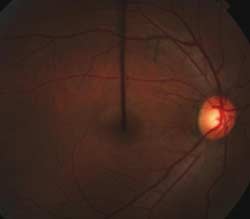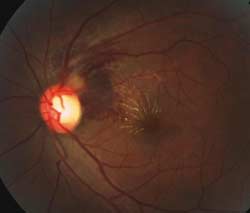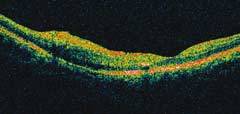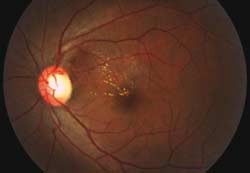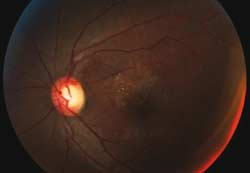Man presents with 10-day history of floaters, blurry vision in left eye
 Jeffrey Chang |
 Vivek Chaturvedi |
A 33-year-old man of Indian origin presented with a 10-day history of increased floaters and blurry vision in his left eye. He denied photopsias, eye redness or pain.
The patient’s ocular history included occasional dry eye. His medical history was unremarkable, and he was not on any medications. A thorough review of systems was negative.
Examination
On exam, the patient’s best corrected visual acuity was 20/15 in the right eye and 20/30 in the left eye with no improvement with manifest refraction. His IOP was 16 mm Hg in the right eye and 17 mm Hg in the left eye. Extraocular muscles were full in both eyes, and pupils were symmetric and reactive with no relative afferent pupillary defect.
The right eye anterior segment exam was unremarkable. The left eye slit lamp exam was notable for rare vitreal cells and debris. Fundus examination of the right eye was normal. The left eye showed a macular star of lipid exudates, an elevated yellowish lesion near the superotemporal aspect of the optic nerve, and peripapillary, subretinal and nerve fiber layer hemorrhages (Figure 1). Optical coherence tomography of the macula showed no fluid (Figure 2). Fluorescein angiography showed some leakage around the optic nerve in the left eye (Figure 3).
|
|
|
|
Figures 1a and 1b. Color fundus photographs.
The right eye is within normal limits. The left eye has a macular star of lipid
exudates, an elevated yellowish lesion near the superotemporal aspect of the
optic nerve, and peripapillary, subretinal and nerve fiber layer
hemorrhages.
Images: Nandakumar N, Soukiasian
SH |
|
|
|
|
|
Figures 2a and 2b. OCT of the left macula
showing no fluid. |
|
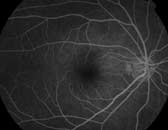 |
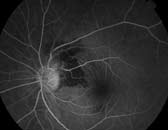 |
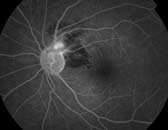 |
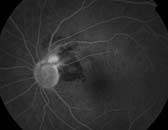 |
|
Figures 3a, 3b, 3c and 3d. Fluorescein
angiography demonstrating leakage around the optic nerve in the left
eye. |
|

What is your diagnosis?
Floaters, blurry vision
A diagnosis of neuroretinitis was made. The differential diagnosis of neuroretinitis includes infectious causes such as syphilis, toxoplasmosis, hepatitis B, Lyme, and cat scratch disease; non-infectious causes sarcoidosis and multiple sclerosis; and idiopathic causes.
An extensive workup, including serum angiotensin converting enzyme, lysozyme, c-reactive protein, liver function tests, FTA-ABS, Lyme antibodies, toxoplasma and Bartonella titers, was performed and was within normal limits. A chest X-ray showed old healed granulomatous disease in the right hilar lymph nodes. A chest CT showed peripheral punctate calcified granulomas and a single small calcification anterior to the heart behind the sternum, consistent with inactive granulomatous disease. A QuantiFERON-TB Gold assay was performed and was positive.
QuantiFERON-TB Gold is a test approved by the U.S. Food and Drug Administration for use as an aid in diagnosing latent and active mycobacterium tuberculosis. Heparinized whole blood is incubated with synthetic peptides of ESAT-6 and CPF-10 antigens, and the concentration of interferon gamma is determined via enzyme-linked immunosorbent assay. The test is comparable to the tuberculin skin test and can be used in patients who have been vaccinated with Bacille Calmette-Guérin.
|
|
|
|
|
Figures 4a, 4b and 4c. Color fundus
photographs showing improvement in retinal exam with treatment. |
||
Upon further questioning, we found the patient had emigrated from Southern India to the United States 8 years prior. There was neither a history nor known exposure to tuberculosis. His last PPD test was 1 year prior and was negative. His last visit to India was 2 months prior. He had no symptoms of fever, chills, cough, malaise, anorexia or fatigue.
Given the patient’s history and recent positive QuantiFERON-TB Gold, tuberculous neuroretinitis was high on our differential. Ocular tuberculosis can present in a number of diverse clinical scenarios, including anterior uveitis, posterior uveitis, panuveitis, retinitis, retinal vasculitis, optic atrophy and neuroretinitis. The diagnosis is often presumptive, as it is difficult to obtain tissue or fluid to demonstrate tubercle bacilli.
Our patient was started on a standard course of antitubercular treatment. A dramatic improvement in visual acuity and neuroretinitis was noted in a 3-month period (Figure 4). We diagnosed the patient with presumptive tuberculous neuroretinitis.
References:
- Albini TA, Karakousis PC, Rao NA. Interferon-gamma release assays in the diagnosis of tuberculous uveitis. Am J Ophthalmol. 2008;146(4):486-488.
- Bansal R, Gupta A, Gupta V, Dogra MR, Bambery P, Arora SK. Role of anti-tubercular therapy in uveitis with latent/manifest tuberculosis. Am J Ophthalmol. 2008;146(5):772-779.
- Bhatti MT, Asif R, Bhatti LB. Macular star in neuroretinitis. Arch Neurol. 2001;58(6):1008-1009.
- Morbidity and Mortality Weekly Report. Guidelines for using the QuantiFERON-TB Gold Test for detecting Mycobacterium tuberculosis infection, United States. http://www.cdc.gov/mmwr/pdf/rr/rr5415.pdf. Accessed Jan. 30, 2009.
- Gupta V, Gupta A, Rao NA. Intraocular tuberculosis: An update. Surv Ophthalmol. 2007;52(6):561-587.
- Mackensen F, Becker MD, Wiehler U, Max R, Dalpke A, Zimmermann S. QuantiFERON TB-Gold: A new test strengthening long-suspected tuberculous involvement in serpiginous-like choroiditis. Am J Ophthalmol. 2008;146(5):761-766.
- Madge SN, Prabhakaran VC, Shome D, Kim U, Honavar S, Selva D. Orbital tuberculosis: A review of the literature. Orbit. 2008;27(4):267-277.
- Namrata Nandakumar, MD, and Sarkis H. Soukiasian, MD, can be reached at Tufts Medical Center, 750 Washington St., Box 450, Boston, MA 02111; 617-636-4219; fax: 617-636-4866; Web site: www.neec.com.
- Edited by Jeffrey Chang, MD, and Vivek Chaturvedi, MD. Drs. Chang and Chaturvedi can be reached at New England Eye Center, Tufts University School of Medicine, 750 Washington St., Box 450, Boston, MA 02111; 617-636-4219; fax: 617-636-4866; Web site: www.neec.com.

